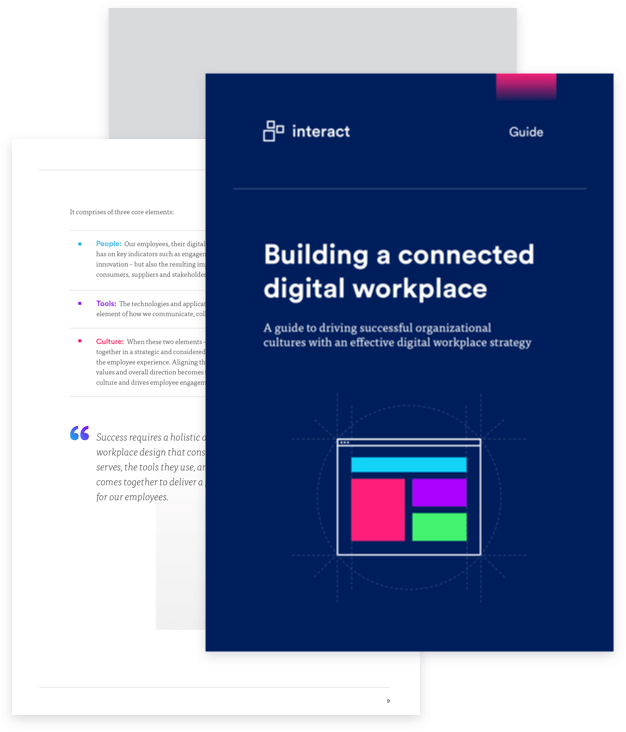Intranet translation tools: Why you need to be speaking your employees’ language

If there are language barriers in your organization, you could be facing big problems. We explore how intranet translation tools are changing the way we work.
In an increasingly globalized world, there are more nationalities, languages, and cultures in the workplace than ever before. While companies focus on growth, and in some cases, having reach across the planet, they could be missing out on something vital to the long-term health of their business. To strengthen the foundations of your business, you need to have a strategy. A strategy that makes sure that every employee in your organization does not encounter a language barrier in their day-to-day working life.
Nielsen describes multicultural populations as “the growth engine of the future in the United States.” Businesses are enriched by the insights, ideas, and skills from talent across every demographic. More than 40 million people living in America were born elsewhere. However, about half of all immigrants ages five and above have limited English proficiency, according to a recent Pew Research Center report.
When these generations enter the workforce, how well will they thrive in predominately English-speaking organizations?
Building a connected digital workplace
The language barrier: the scourge of the modern workplace
According to a survey by Rosetta Stone, 90 percent of organizations struggle with language barriers in their day-to-day work.
Workers who aren’t receiving information, training, and updates in a language that they fully understand, aren’t able to give their best. As a result, your business opens itself to serious issues. These issues could vary from the personal to the financial and may include:
Breakdown in relationships: there are myriad ways that a language barrier could create problems in a working relationship. From a poorly translated phrase to a misinterpreted comment, it’s very easy for people to take offense when the organization hasn’t invested in proper translation tools.
Isolation: When your organization is multi-lingual, you need to make the utmost effort to make sure everyone is represented. There are various ways for businesses to overcome language problems and allow their talent to shine. Providing translation in their language, or introducing a work buddy that is fluent in their tongue – these efforts can prevent isolation from setting in, allowing all colleagues to converse and socialize with ease.
Operational error: How sure are you that your organization understands all the risks associated with their work? It’s easy to make a mistake in any job, but when that mistake has a significant impact, and the reasons are down to the worker not receiving the adequate translation, you have a problem.
Incomplete training: Training is critical to every job, which is why it’s so important to assess understanding at every stage. Rather than presuming your worker is happy to train up in English, it’s worth providing them with a copy of their coaching in their first language. This will enhance their understanding, particularly in the more technical, complex areas.
As stated, it’s crucial that all employees – even freelancers and contractors – have a complete understanding of what you and your organization requires of them. So how do you do go about this?
Translation is a huge development in the digital workplace and one that organizations must invest in to stay ahead of the curve. Software has developed sophisticated ways of translating to take into account all the richness of languages, slang, informalities, and abbreviations.
Why organizations need to focus on translation tools now

As mentioned, very few companies right now are investing in proper language learning applications for their personnel. But there has been a gradual movement in many industries – particularly those with a global span. Businesses want to capture as many customers as possible and are looking into using the best language translation tools available to make their products available to a widening audience.
These consumer translation tools can be applied to the workforce – using the same technology to minimize the language divide in the workplace.
Offering language training not only increases staff productivity in their roles; it also has a considerable impact on a more profound level. Learning a language through conversations with friends and colleague provides a deeper and more complex understanding than a school-style learning system. People who study new languages can learn societal behaviors, cultural norms, idioms, at the same time as fully understanding a new culture.
Workplace language learning usually falls under workforce development programs. But only 25 percent of businesses are incorporating language learning into individual development plans. This is predicted to increase as the digital workplace matures. This means training can be done anywhere. Technology like mobile intranets and e-learning programs enable staff members to learn on the go. It could also mean that at some point, learning is no longer necessary – the machine does all the work while the user carries on communicating in their first language.
Building a connected digital workplace
The benefits of translations tools in the digital workplace
The benefits of being able to fully understand and communicate with your colleagues regardless of what language is spoken really need no explanation.
However, the majority of global businesses rely on employees being able to have a good grasp of the English language. For most of the world, it seems unjust that English native speakers have this unfair advantage. As a second language, there is the chance of missing nuances, misunderstanding slang, which could change the meaning. These workers may not be equipped with the cultural insight into many of the work chats and discussions that their English-speaking native colleagues have, and therefore be at a disadvantage.
This reliance on foreign workers needing to speak English is great for businesses – it means that there is little effort on the part of the organization. But conversely, it also means that businesses are vulnerable to serious issues and risks – all of which could be countered by providing a modern, up-to-date digital employee experience.
Overcoming the language barrier with intranet translation tools

In this case, it all starts with the keystone of your digital workplace: your intranet. Your business intranet acts as the touchstone for every employee to check in with the business and their colleagues – whether they’re stationed at the headquarters or halfway around the world. Designed to be accessed on the go, at the desk or during lunch hours, your intranet also needs to be able to have the agility to be relevant to all workers. Which means when you have staff whose first language isn’t English, it’s imperative that you offer them a translated version in a language that they use every day.
Intranet translation tools open up a host of advantageous opportunities for the foreign speaker. With their intranet translated into their first language, they are fully able to exploit all the benefits of an intranet.
Of course, most workers were able to operate an English-speaking intranet with English as a foreign language in the first place. However, giving the employee the chance to operate it in their first language changes things. These might appear subtle but will have a massive difference in the user’s engagement of the intranet, and therefore, engagement with the workplace. The various ways a foreign speaker can benefit from intranet translation tools include:
Take part in forums: When the questions, suggestions, ideas, and feedback are translated into the user’s first language, it provides a deeper level of understanding. This improved understanding can allow the user to participate in discussions efficiently. This has an enormous impact on collaboration and relationships: different languages are no longer seen as an obstacle – the intranet is facilitating strengthened work bonds.
Communicate with colleagues: With translation tools, there is better understanding of the strengths and skillsets of foreign-speaking workers. For example, if you need help with an issue and you know your Italian colleagues in Rome are specialists in the field, your intranet can act as your interpreter to allow you to overcome the language barrier. This has significant value to a global organization who will observe very natural silos form based on geographical locations.
Commenting and liking on posts: While the idea of follows, likes and comments may appear ‘fluffy’, the social aspect of an intranet has considerable value to any businesses. It increases engagement, supports good ideas, and allows for healthy discussion. While this is incredibly powerful when localized offices can communicate all together, when you have different countries adding to the mix, you have unbridled access to incredible insights from your organization’s talent.
So how do intranet translation tools work?

Interact’s technology has a number of translation features that make communication between two languages easy.
Firstly, the product language can be assigned to members of a location or an individual user via their profile. These language packs allow users to experience their homepages and communications in their native tongue.
Language packs currently available are English – UK, English – US, and Spanish – Latin America. These are set to increase with 21 further language packs coming in the next two months with automatic product releases to ensure the functionality continues to evolve.
A system text edit feature is available to access all product content and translate as needed. System text gives a better UX and a native experience with the software, ensuring they employees don’t face barriers trying to navigate around.
Much like the translation button on apps such as IG or Facebook, on-demand translation increases communication and collaboration between teams. This machine-based translation will automatically detect non-language pack text and offer a ‘translate’ option for conversational, real-time translation; with built-in intelligence, it will learn as it goes, adjusting for in-house terminology for example. Users can read and understand the timelines of their international colleagues, building better connections.
The complexities of the packs will continue to develop and is simply a sign of the times. A tool that can grease the wheels of global enterprise and allow people from different countries, different languages and different cultures to communicate, understand and unite must surely be a powerfully positive addition to the workplace – and to society – surely?

